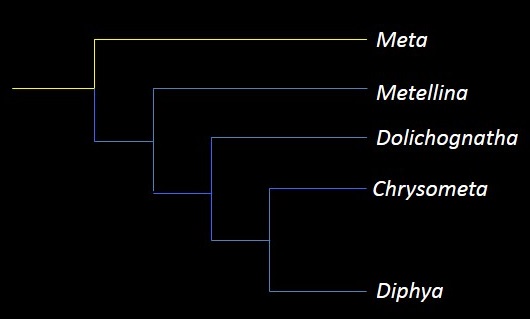
Classification
Domain: Eukarya
Like all animals, plants and fungi, Meta menardi is included
into the domain
Eukarya. The organisms in this domain all
contain membrane bound organelles. Some examples are
mitochondria, smooth and rough endoplasmic reticulum, lysosomes,
and chloroplasts. These organisms also contain the very
important organelle, nucleus (Animal Diversity Web, 2013).
Kingdom: Animalia
Organisms of this kingdom are multicellular and
heterotrophs
(organisms that consume other organism for energy and
nutrients). Tissues are also important characteristics of the
kingdom Animalia, making up the bodies of animals (other than
sponges) and can even specialize and become organs (Animal
Diversity Web, 2013, Encyclopedia of Life Web, 2014).
Figure 1. Phylogenic tree showing pathway to phylum Arthropoda where
Meta
menardi can be found.
Phylum: Arthropda
Arthropda are numerous in number and are characterized by their
segmented bodies (head, thorax, and abdomen) and their paired
jointed appendages. Shedding or molting of the chitin
exoskeleton is also apparent in organism found in the phylum
Arthropda during growth stages. Some more synapomorphies found
in Arthropda include: bilateral symmetry, nervous system found
in the belly, open circulatory system and ventral (Encyclopedia
of Life Web, 2014).
Class: Arachnida
The class of Arachnida include organism such as spiders, mites,
ticks and
scorpions. These entire organisms in the class
Arachnida possess eight pairs of appendages that allow for
movement with an addition of two appendages that aid in feeding
or defense. Arachnida also have the fusion of their head and
thorax resulting in only having two segmented body parts
(Discover Life in America Web, 2014).
Order: Araneae
Order Aranea are the
spiders.
Family: Tetragnathidae
Spiders found in the family of Tetragnathidea are also known as
long jawed orb weavers. There are 966 species in this family
with many being found in North America and Mexico. The bodies of
Tetragnathids are distinct with the first pair of legs being the
longest and the third being the shortest. The webs that are spun
by the Tetragnathdae spiders are orb shaped with an open hub at
the center (Encyclopedia of Life Web, 2014).

Subfamily: Metainae
This subfamily of Metainae consists of 5 genera: Meta,
Metellina, Dolichognatha, Chrysometa, and
Diphya spiders (Encyclopedia of Life Web, 2014).
Figure 2. Metainae phylogenic tree showing species closely related to the genus Meta.
Genus: Meta
Being known as “cave orb weavers” spiders of the genus
Meta are
found in caves or dark damp environments (Encyclopedia of Life
Web, 2014).
Species: Meta menardi
The Meta menardi spider is placed into the respective species
due to the dark coloration, pale or brown abdomen, the dark
rings on the legs and also for the general environment that they
live in. The Meta menardi is quite similar to the other spider
species Meta bourneti in coloration and often confuses people
about which one is which. The difference can only be seen
through a microscope (Encyclopedia of Life Web, 2014).